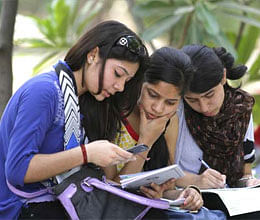
Indian universities have grabbed 10 of the top 100 slots in the first-ever rankings of higher education institutions from emerging economies across the globe, a list dominated by Chinese varsities.
The Times Higher Education magazine, known for its definitive educational rankings, published the world's first ranking for universities in Brazil, Russia, India, China and South Africa (BRICS) and 17 other emerging economies.
Pakistan was included in the analysis, but none of its institutions make the tables.
Indian representation is led by Panjab University, which comes in joint 13th with China's Renmin University.
The alma mater of Prime Minister Manmohan Singh is followed by Indian institutes of Technology (IITs) including Kharagpur (30th), Kanpur (34th), Delhi and Roorkee (joint 37th), Guwahati (46) and Madras, which shares 47th place with Jadavpur University.
Aligarh Muslim University (50th) and Jawaharlal Nehru University (57th) are those included beyond the top 50.
"This is a strong showing for India and despite limitations it has done much better than many major BRIC countries like Russia and Brazil. This table should offer encouragement, it highlights the nation's real strengths in competition with countries that offer fair comparisons," said Phil Baty, editor of the Times Higher Education Rankings.
In reference to some of the Indian Institutes of Management (IIMs) missing from the list, he added: "Much of it is to do with a limited pool of 20 universities that shared their data for this particular analysis. We are expecting an explosion in time for next year's rankings as more and more Indian universities embrace the global rankings system."
India remains conspicuously absent from the top 10, which is largely dominated by Chinese institutions with Peking and Tsinghua University coming in at No 1 and 2.
In total, China has six top 20, 15 top 50 and 23 top 100 institutions, earning it the tag of being the number one country in the overall analysis for emerging economies.
"China has always put having globally competitive universities on the top of its agenda and hand-picked a small top tier that was groomed to be world class. India was focused on the massive demand for places, and rightly so, but it is now entering an era where the focus will be more on global standards and quality," explained Baty.
"A country of India's enormous size, growing wealth and immensely rich intellectual history should aspire to more and Times Higher Education looks forward to continuing its valuable discussions with sector leaders and government ministers in helping Indian institutions to benchmark and monitor their progress against our trusted, independent global standards," he added.
The latest annual tables, a subsidiary of the prestigious Times Higher Education World University Rankings, are based on the same range of 13 rigorous performance indicators used to create the annual world university rankings including teaching, research, knowledge transfer and international outlook.
Taiwan has 21 institutions ranked in the top 100 list and nine Taiwanese institutions make the top 50, led by National Taiwan University (4th).
Southeast Asia overall is well represented in the table with Thailand?s five top 100 institutions and Malaysia's two representatives.
Although considered as part of the analysis, Indonesia and the Philippines do not make the top 100.
South Africa boasts the highest ranked university outside China, the University of Cape Town (3rd) and five other top 100 representatives.
Brazil's flagship institution, the University of Sao Paulo, just misses out on a top 10 position and Russia has only two top 100 players, with Lomonosov Moscow State University (10th) and St Petersburg State University (67th).
Turkey emerges as China's closest competitor with three universities in the top 10 and five in the top 20.
"Of the BRICS, China's utter dominance should serve as testament to what can be achieved when a nation puts the development of outstanding research and higher education at the heart of its economic strategy.
"It seems poised to make the most of its talent and to become highly competitive in the new world order of knowledge. But the rankings should also serve as a warning to the other BRICS that they risk losing out in the global race if they do not put further energy and resources into developing their universities to compete with the very best," the analysis concludes.
The Times Higher Education magazine, known for its definitive educational rankings, published the world's first ranking for universities in Brazil, Russia, India, China and South Africa (BRICS) and 17 other emerging economies.
Pakistan was included in the analysis, but none of its institutions make the tables.
Indian representation is led by Panjab University, which comes in joint 13th with China's Renmin University.
The alma mater of Prime Minister Manmohan Singh is followed by Indian institutes of Technology (IITs) including Kharagpur (30th), Kanpur (34th), Delhi and Roorkee (joint 37th), Guwahati (46) and Madras, which shares 47th place with Jadavpur University.
Aligarh Muslim University (50th) and Jawaharlal Nehru University (57th) are those included beyond the top 50.
"This is a strong showing for India and despite limitations it has done much better than many major BRIC countries like Russia and Brazil. This table should offer encouragement, it highlights the nation's real strengths in competition with countries that offer fair comparisons," said Phil Baty, editor of the Times Higher Education Rankings.
In reference to some of the Indian Institutes of Management (IIMs) missing from the list, he added: "Much of it is to do with a limited pool of 20 universities that shared their data for this particular analysis. We are expecting an explosion in time for next year's rankings as more and more Indian universities embrace the global rankings system."
India remains conspicuously absent from the top 10, which is largely dominated by Chinese institutions with Peking and Tsinghua University coming in at No 1 and 2.
In total, China has six top 20, 15 top 50 and 23 top 100 institutions, earning it the tag of being the number one country in the overall analysis for emerging economies.
"China has always put having globally competitive universities on the top of its agenda and hand-picked a small top tier that was groomed to be world class. India was focused on the massive demand for places, and rightly so, but it is now entering an era where the focus will be more on global standards and quality," explained Baty.
"A country of India's enormous size, growing wealth and immensely rich intellectual history should aspire to more and Times Higher Education looks forward to continuing its valuable discussions with sector leaders and government ministers in helping Indian institutions to benchmark and monitor their progress against our trusted, independent global standards," he added.
The latest annual tables, a subsidiary of the prestigious Times Higher Education World University Rankings, are based on the same range of 13 rigorous performance indicators used to create the annual world university rankings including teaching, research, knowledge transfer and international outlook.
Taiwan has 21 institutions ranked in the top 100 list and nine Taiwanese institutions make the top 50, led by National Taiwan University (4th).
Southeast Asia overall is well represented in the table with Thailand?s five top 100 institutions and Malaysia's two representatives.
Although considered as part of the analysis, Indonesia and the Philippines do not make the top 100.
South Africa boasts the highest ranked university outside China, the University of Cape Town (3rd) and five other top 100 representatives.
Brazil's flagship institution, the University of Sao Paulo, just misses out on a top 10 position and Russia has only two top 100 players, with Lomonosov Moscow State University (10th) and St Petersburg State University (67th).
Turkey emerges as China's closest competitor with three universities in the top 10 and five in the top 20.
"Of the BRICS, China's utter dominance should serve as testament to what can be achieved when a nation puts the development of outstanding research and higher education at the heart of its economic strategy.
"It seems poised to make the most of its talent and to become highly competitive in the new world order of knowledge. But the rankings should also serve as a warning to the other BRICS that they risk losing out in the global race if they do not put further energy and resources into developing their universities to compete with the very best," the analysis concludes.









